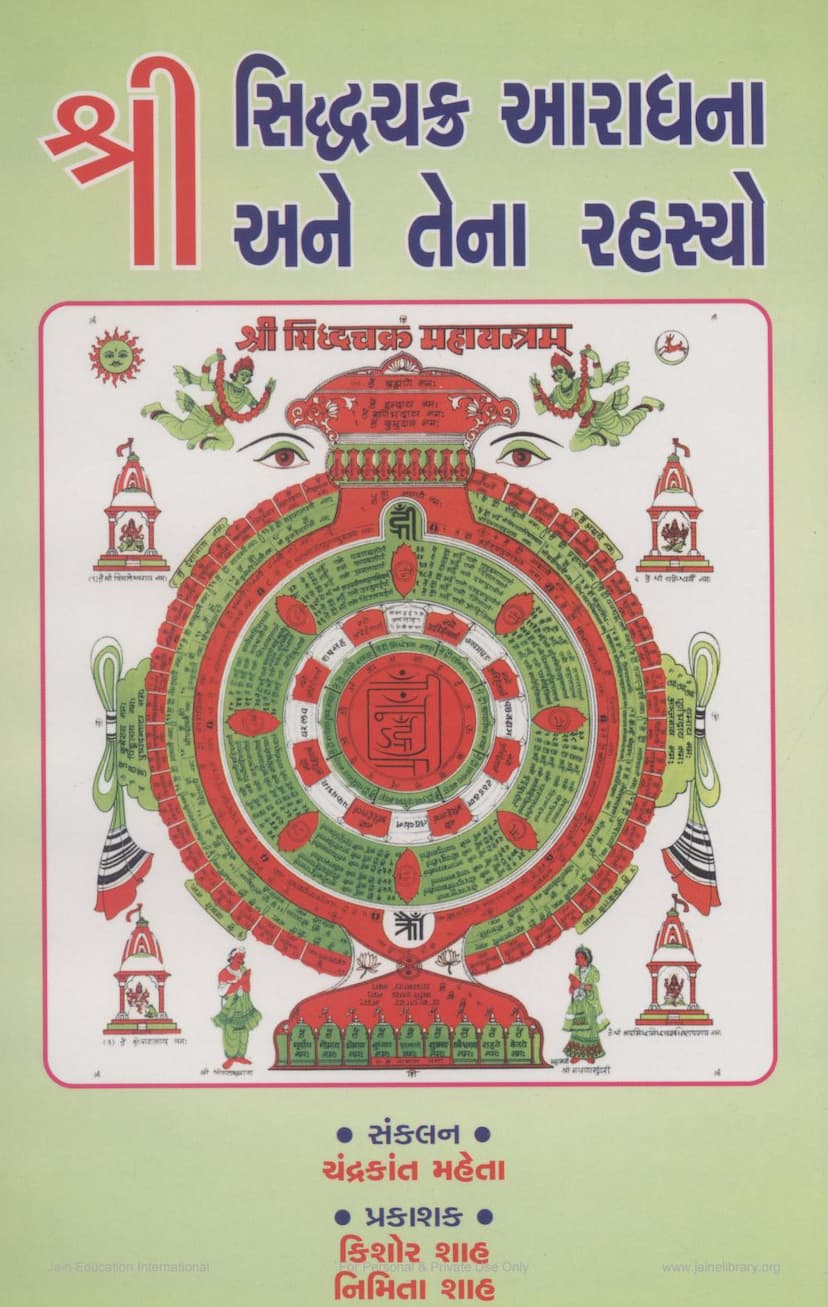Siddhachakra Aradhana Ane Tena Rahasyo
Added to library: September 2, 2025

Summary
This document is a summary of the Jain text "Siddhachakra Aradhana ane Tena Rahasyo" (Siddhachakra Worship and Its Secrets) by Chandrakant Mehta. The book, published by Kishor Shah and Nimita Shah, focuses on the significance, rituals, and underlying principles of worshipping the Siddhachakra.
Here's a breakdown of the key aspects covered in the text, based on the provided pages:
1. Introduction and Significance of Siddhachakra:
- Ancient Origin: The Siddhachakra is described as an ancient and supreme mantra-yantra, holding profound secrets. Its origins are traced back to the "Vidyanuvada" (Knowledge Discourse) section of the ancient Jain scripture "Drishtivada," specifically the tenth Purva. It's highlighted that great souls like Acharya Ratnashekhar Suri and Labdhadhari Shri Vajraswami have elaborated on its importance.
- Core of Jainism: The Siddhachakra is presented as central to Jainism, with the Navapada (nine divine beings) at its core, and Arihant at the center of the Navapada.
- Multiple Meanings: The name "Siddhachakra" itself is broken down: "Siddha" meaning pure, accomplished, or unfailingly fruitful, and "Chakra" meaning a circular device or diagram. Thus, it represents a pure, miraculous, and unfailingly beneficial circular diagram.
- Navapada Structure: It is explained that the Siddhachakra is a "Navapadatmaka" (comprising nine divine entities) mechanism that unifies the three essential elements of faith: God (Arihant, Siddha), Guru (Acharya, Upadhyaya, Sadhu), and Dharma (Righteousness, represented by Right Faith, Right Knowledge, Right Conduct, and Right Austerity).
- Mechanism of Karma Destruction: Similar to a machine or an oil-press (ghani) that crushes substances, the Navapada mechanism of the Siddhachakra is said to crush karmas.
- Historical Examples: The legendary story of King Shripal and Queen Mayanasundari is cited as a prime example of the Siddhachakra's power, where their devotion helped them overcome difficulties and secure their spiritual liberation.
2. The Worship (Aradhana) of Siddhachakra:
- Two Methods: Worship can be performed in two ways:
- Collective Maha-Pujan: Grand public worship conducted by a ritualistic expert in temples or holy places.
- Individual Laghu-Pujan: Smaller, personal worship that can be done at home.
- Importance of Understanding: The text emphasizes the necessity of knowing and practicing the Siddhachakra's worship rituals.
- Guidance from Scholars: The author, Chandrakant Mehta, acknowledges the inspiration from various scholars and spiritual guides, including Pandit Dheerajlal Tokershi for his works on mantra sastra.
- Personal Experience: Mehta shares his journey of regularly worshipping the Siddhachakra for the past decade, conducting similar sessions in various countries, and being inspired by the need to share this knowledge through a book.
3. The Secrets (Rahasyo) of Siddhachakra:
- Mantra and Yantra: The text delves into the importance and significance of both mantras (sacred syllables) and yantras (sacred diagrams).
- Mantras: Defined as frequently contemplated words, verses, principles, or texts that offer protection and are bestowed by a Guru. Jain mantras are considered holy and worthy of worship as they are divinely inspired by Tirthankar Bhagwan and codified by Ganadhar Bhagwan. The importance of proper pronunciation, purity, faith, and adherence to rituals for mantra efficacy is stressed.
- Yantras: Highlighted for their structural importance, with various geometric shapes like triangles, squares, circles, and their combinations used to create specific energies. The Siddhachakra yantra is a complex and powerful diagram.
- The Core Mantra: The central mantra of the Siddhachakra is identified as "Om Hrim Aham Namah" (ॐ ह्रीं अहँ नमः). The composition of "Aham" (अहं) is explained as consisting of "A" (अ), "Ra" (र), "Ha" (ह), and a dot (bindu), each having profound spiritual significance. The integration of "Om," "Hrim," and "Aham" into a powerful mantra is detailed.
- Detailed Structure of the Yantra: The book provides a comprehensive explanation of the Siddhachakra yantra's intricate structure, describing its thirteen concentric "valayas" (layers or circles) and the specific deities, mantras, and principles inscribed within each. This includes:
- Inner Core: Arihant (Aham mantra).
- Navapada: The nine divine beings (Arihant, Siddha, Acharya, Upadhyaya, Sadhu, Right Faith, Right Knowledge, Right Conduct, Right Austerity).
- Swaras (Vowels) and Varnamala (Alphabets): Representing Vidya Devis and the power of language.
- Laddhis (Supernatural Powers): Detailing 48 specific Siddhis acquired by advanced souls.
- Gurus' Footprints (Paduka): Symbolizing the blessings and guidance of spiritual preceptors.
- Devi-Devatas and Guardians: Including Jayadi Devis, Vidya Devis, Yaks, Yakshinis, Dwarapalas (gatekeepers), Viras (heroes), Dikpalas (direction guardians), Navagrahas (nine planets), and Navanidhi (nine treasures).
- Symbolic Representations: The yantra incorporates elements like kalasha (pot), eyes, and decorative elements, all carrying symbolic meanings related to auspiciousness, vigilance, and the hidden secrets within.
- Rituals and Practices: The book outlines specific ritualistic steps, including purification of the ground (Bhoomi Shuddhi), mantra bath (Mantra Snan), purification of sins (Kalmash Dahan), heart purification (Hriday Shuddhi), invocation of deities (Adhishthayak Devtaon ka Aahvan), Navapada worship, and concluding prayers (Visarjan, Kshamayachana).
- Mantra Recitation: Emphasis is placed on reciting specific mantras, often 27 or 108 times, for each of the Navapada and other important deities.
- Benefits of Aradhana: The worship is said to bring success in all endeavors, fulfill desires, remove suffering, grant spiritual progress, and ultimately lead to liberation (Moksha).
4. Authors and Supporters:
- Chandrakant Mehta: The compiler and author, a regular worshipper and proponent of Siddhachakra, who has conducted many spiritual sessions globally.
- Kishor and Nimita Shah: The publishers, who are dedicated followers and sponsors of spiritual activities.
- Acknowledged Gurus and Scholars: The author expresses gratitude to his spiritual teachers and scholars who guided him in understanding the Siddhachakra and its secrets, including Pandit Dhirajbhai Mehta, Pt. Dhirajlal Tokershi, Acharya Somchandrasurishwarji M.S., Dr. Kumarpal Desai, and others.
Overall Purpose:
The book aims to provide a comprehensive guide for Jain practitioners to understand and perform the Siddhachakra worship with deep devotion and comprehension of its underlying principles, leading to spiritual upliftment and the attainment of desired goals, ultimately including Moksha. It bridges the gap between ritualistic practice and the philosophical understanding of this potent spiritual tool.